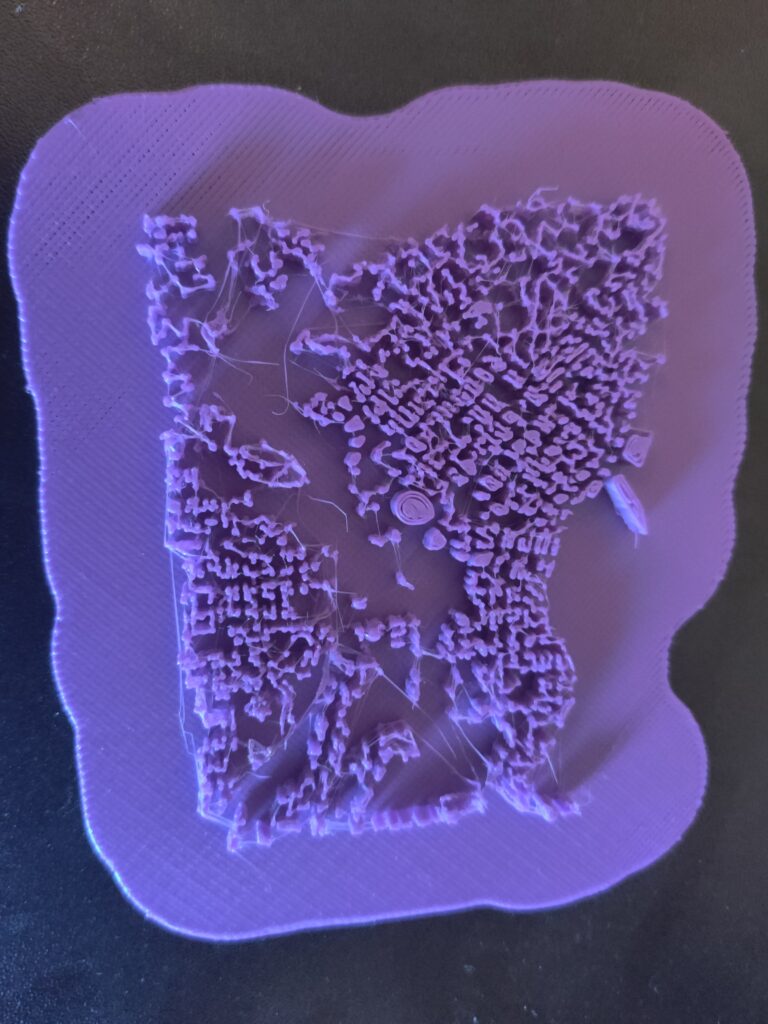Introduction: Provide a basic overview of your project. Describe in one to two paragraphs what your goal was and provide a short description of what you did. Include one beautiful photograph of your final project in this section.
My project consists of 3 parts. A forget-me-not flower blossom, a vase that is based on the shape of a tulip, and a model of Downtown Vancouver, CA. I used importing GeoJson to make the model of Vancouver using the city’s building footprints. I used the Extruder Turtle library to make the flower based objects.
Background Research: Describe how your project relates to previous work. Discuss the related work you have found and explain how it relates to or inspired your project. Include links, and (if applicable) images of the related work. Related work should be in the form of an original source. It can be an academic paper or thorough documentation of a designer’s or artist’s work. If you are a graduate student enrolled in CS591 your related work must include two or more academic papers.
For this project, I took heavy inspiration from Darlene Farris, her 3D printed flowers had the most amazing shapes, colors, and looked so real. My forget-me-nots and my tulip based vase are both inspired by her works on her website. Additionally, I combined ideas from Biggs, Coughlan, and Coppin with Shears, Stocks, and Bagg as well as put my own spin on it. When I first started this project I wanted to do a topological map, but I pivoted after I realized that I could download the building footprints from the City of Vancouver. I decided to base my model of Vancouver off of the building footprints, almost like a google maps view. Which has the data use seen in Coppin, et al. and the visualization of the map made in Biggs, et al.
Darlene Farris Inspiration:


Process: Describe in detail how you designed and fabricated your project. Describe your program(s) and how they work. Discuss any challenges you encountered during the process. Describe your fabrication process(es) and any challenges you encountered.
I wanted to start out on a high note, so I tried designing a forget-me-not flower blossom first. The forget-me-not is generated using 2 functions, a draw-center and draw-petals. First it draws the center of the forget me not, and then using a variable num_petals draws that number of petals. Since it is a forget-me-not, the number of petals is set to 5 within the script. I think that the petals for this print turned out really well, incorporating non-planar z movements and techniques that I haven’t used heavily before.
I then started working on the model of Vancouver. At first I downloaded the whole GeoJson, converted it to a normal Json, and then created a script in Rhino that generates the building footprints as polyline curves. However, I had two problems with this. I thought it wasn’t working for the longest time so I redownloaded only a portion of the building footprints. I was still coming across the same issue until I noticed a little dot on my screen. I had to zoom in a lot to be able to see the actual object. I was able to get around this because Cura automatically makes it bigger when I was exporting it. I thought that this would be the hardest coding portion, but really it was the hardest printing portion. The filament was struggling to adhere to my bed, so I ended up using a raft adhesion method. This allowed for the filament to have better adhesion, and it turned out really well. I wanted a bigger version, but due to my earlier prints failing, I had to decrease the size so that it didn’t take a whole day to print every time.
Finally, the tulip based vase was my final part of the project. This was made a lot easier since I built off of my forget-me-not code. This script creates lines where you can change the height, radius of the top and bottom, and number of petals (bumps) at the top. Then I loft these lines while capping the bottom two layers to create a vase.
Outcome: Provide beautiful and thorough documentation of your final outcome, including a description of the results and beautiful photographs. Follow the photo tutorial. Also make sure that your photographs are cropped nicely.




I really liked how the prints came out overall. There were some rough parts, but they had the overall shape that I wanted. The strands in Vancouver and the rough patches on the forget-me-not, were 2 parts where if I had more time would try to fix. However, those are just aesthetic issues and the overall structure came out how I wanted.
Future Work: Provide a short discussion of how you would expand or iterate on your project if you had more time.
If I had more time, I would want to spend some more time on my Vancouver model. I had intentions of making it bigger, but since I had a lot of printing errors, I had to decrease it in size so that I could get as many iterations off as possible. I still think it ended up looking really good. I would also add some more flowers of differing varieties.
Reflection: Reflect on what you learned working on this project and how you plan to use the artifacts you created.
I’m using my artifacts as gifts for my girlfriend for Christmas. I think overall the project went really well. I was able to take inspiration from the real world as well as other projects to create objects that are meaningful to us. It wasn’t easy, I had trouble printing the city model and really struggled getting the structure that I wanted for the flowers. However, the petals of the forget-me-not have some of the structures I’m most proud of in the entire class.
Files:
Presentation